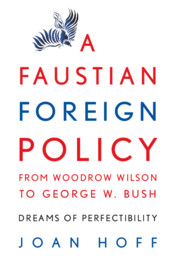Book contents
- Frontmatter
- Contents
- Introduction: Toward a Faustian Diplomacy
- 1 The United States Forms and Refines Its Diplomacy
- 2 The Faustian Impact of World War I on U.S. Diplomacy
- 3 The Faustian Aspects of Prosperity, Depression, and War
- 4 Faustian Aspects of U.S. Cold War Foreign Policy
- 5 Cold War Transformation of the American Presidency
- 6 The United States Adrift in the Post–Cold War World
- 7 Flaunting Faustian Foreign Policy
- Epilogue: The Legacy of George W. Bush
- Notes
- Bibliography
- Index
5 - Cold War Transformation of the American Presidency
Published online by Cambridge University Press: 18 August 2009
- Frontmatter
- Contents
- Introduction: Toward a Faustian Diplomacy
- 1 The United States Forms and Refines Its Diplomacy
- 2 The Faustian Impact of World War I on U.S. Diplomacy
- 3 The Faustian Aspects of Prosperity, Depression, and War
- 4 Faustian Aspects of U.S. Cold War Foreign Policy
- 5 Cold War Transformation of the American Presidency
- 6 The United States Adrift in the Post–Cold War World
- 7 Flaunting Faustian Foreign Policy
- Epilogue: The Legacy of George W. Bush
- Notes
- Bibliography
- Index
Summary
The power of modern American presidents manifests itself in its purest form in the global arena, where their actions as commander in chief can determine the fate of the human race…. However, the president's latitude for independent action is even greater in the unstructured post–cold war world than it was during the cold war when the threat of mutual destruction concentrated minds and constrained actions.
Fred I. Greenstein, The Presidential Difference (2000)To talk of the Cold War only in terms of the impact it had on U.S. foreign policy overlooks how it affected the American presidency. Of the forty-three presidents the United States has had, only twelve of them have held office since 1933: FDR, Truman, Eisenhower, JFK, LBJ, Nixon, Ford, Carter, Reagan, Bush Sr., Clinton, and Bush Jr. Of these, nine have served since 1960, and, except for Eisenhower, they all had previous political experience, including five ex-governors and five vice presidents (three of whom had been senators). Only one, JFK, went directly from being a senator to president, and all twelve are known as modern presidents.
Compared to traditional or premodern presidencies (from George Washington through Calvin Coolidge), in which “Congress was the main engine of national policy-making,” modern presidents are modern because they, rather than Congress, have become the major force driving U.S. diplomacy. Granted, there were a few notable exceptions: the temporary assertions of legislative power in the mid-1930s, and at the end of the Vietnam War and Watergate.
- Type
- Chapter
- Information
- A Faustian Foreign Policy from Woodrow Wilson to George W. BushDreams of Perfectibility, pp. 112 - 133Publisher: Cambridge University PressPrint publication year: 2007



